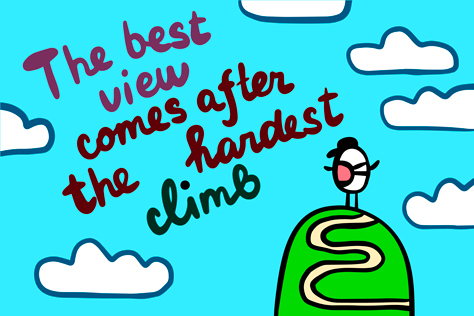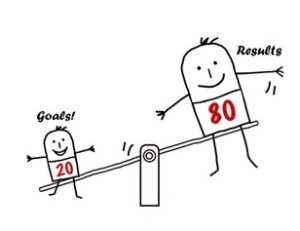
Over the last few months, I have been noticing a particular phenomenon in offices that I don’t think I have seen before… maybe ever. It is like noticing a slight hand tremor that you never knew you had or a buzzing sound from outside that has become increasingly loud and annoying.
2020 was a long year, a stressful one. And you all have been in the thick of it. Daily, seeing more people in one day than most providers see in a week – or more.
My old football coach, Johnny Pappa from Davis, made a big impression on me as a young freshman when he said: “When the going gets tough, the tough get going.” In my then youthful life, I had never heard such profound words. They still apply – especially to you. You are tough!
But stoicism has its limits. The cognitive dissonance can finally get to you.
One doctor expressed to me extreme frustration about two young and very healthy patients, who exercised, got adjusted, ate well, took their vitamins, but decided to discontinue taking their outdoor walks for fear of COVID.
Another doctor, venting his dismay, told me that he couldn’t bear to watch the medical bureaucrats talk about masking and vaccinations as the only remedies to COVID when he knew of so many methods that have been demonstrated to ameliorate the virus. “People are frightened and told to stay at home, don’t socialize, wear a mask if you go out, and wait for the vaccine. That’s it? That’s all you got for people? This really shuts people down.”
One doctor I talked to who, after dealing with depressed and suicidal patients, many of them vets, has become depressed himself. Another wonders what the hell is happening to our chiropractic colleges – have they all been taken over by medical bureaucrats? Is chiropractic finally squashed?
Your good nature can become frayed, your patience worn thin, and regardless of your professional composure and your disciplined countenance, the stresses can have an affect. I mention this because most of you are tough as nails – you have successfully dealt with many types of stressful situations in the past, as a doctor, professional, and for many of you, a business owner.
Morale Virus
So if you are feeling a bit off, recognize that you might be affected by a contagious “Morale Virus.” The Morale Virus is what I call the social sickness that occurs as an emotional response to continual fear-baiting. Frightened, your patients are told they can’t do this and shouldn’t do that.
The Morale Virus is not caused by hardship itself. It is caused when you are pushed into a corner and given no way to fight back. You tend to give up. (Or go stark raving mad!) (Reminds me of the movie, One Flew over the Cuckoo’s Nest when the star, McMurphy (Jack Nicholson), says: “You guys complain how much you hate it here, and then don’t even have the guts to leave! You’re all crazy!”)
There has been a constant assault of bad news emanating from officials and authorities. Yes, and I know the media plays a part — it is mostly owned and controlled by just a few rich people and corporations who have their own agenda — namely, more money. But still – no one buys boring newspapers. Sensation sells the news, and we, the consumers, buy it. We listen and read the “news” that riles us up and confirms our bias. Social media does the same, times ten.
I make my living off the evening news
Just give me something, something I can use
People love it when you lose. They love dirty laundry
We got the bubble-headed bleach-blonde who comes on at five
She can tell you about the plane crash with a gleam in her eye
It’s interesting when people die, give us dirty laundry
Morale Virus Disinfectant
Here are some ideas on how you can fight back, disinfect your office from this disease, and better help your patients regain their spirit of hope, kindness, and free enterprise. And yours as well.
Good Vibe Year
One doctor we work with likes to anchor her practice around a yearly theme. For 2021, she is calling 2021 the year of Good Vibes and has events planned to support this philosophy. And just to reinforce the idea, she has T-Shirts made that say Good Vibes. (And by the way, she has a bustling two-doctor office.)
Study. Acquire More Knowledge. Teach
Fear is often a byproduct of lack of knowledge – so arm yourself with the facts.
For example: Roommate 1: “Oh my god! (A panic shout is heard.) The television isn’t working and the game is on. What will we do?” (Drama ensues.) Roommate 2:(Calmly) “Check the remote for new batteries.” Roommate 1: “Ah, that fixed it, thanks.”
Study, use critical thinking, avoid bias – your own and others. Go to the sources – research studies and from people who are actually working on what you are studying. Then, please educate your patients and clients on how to be happier and healthier. And educate your team, help them increase their knowledge. Arm them as well. Doctor comes from the Latin to docere – “to show, teach, cause to know.”
Leverage Point
What area in your office, if changed, will produce the most significant effect?
Obviously, first and foremost is the doctor. Each day should be a trip to the playground, the ski slope, the baseball field, the dance floor. Ideally, each day is a fresh opportunity to accept the privilege of helping as many people from suffering as possible, to teach them, and have fun doing so.
In most offices, I would also say it is your front desk. The front desk’s power is so poorly recognized in most offices that at least 20% or more production is lost. A vibrant, aggressively friendly, caring, mission and goal-oriented front desk can and will boost your volume – this week. Front Desk team members may need more support and less admin (billing) duties. They may need a better understanding of the mission and how your office is helping people.
Entrepreneur Harder
During cultural upheavals and shifts, entrepreneur businesses remain and often thrive. New opportunities open up. More established and larger companies are weighed down by dogmatic rituals, have high overhead and many vice presidents, and vast networks of suppliers. Change is difficult. But not for the entrepreneur. Most entrepreneurs are all too “change-happy.” You can adapt, innovate, and overcome quicker than companies who are afraid to or can’t. So what if in-person care classes are out for now? Get everyone on a Zoom class, give them a secret word. Test them when they come in again and if they answer correctly, give them a gift – a bottle of Vitamin D or a lunch at another patient’s business.
Stay Out of the Weeds
One doctor told me that her solution was to “stay out of the weeds.” To stay in her lane and just keep helping people and not get caught up in the storms of controversy. I suggest that this is the best course of action. You want news? Sensational news…? Just listen to your patients and staff and community. But stay on the fairway and don’t get sidetracked, mentally or in real life.
Goals
Stay with your goals. Goals are agreements that you made with yourself, and usually others. If you stay true to them, they will lead you out of the den of the morale sickness. Staying true to your goals is a point of integrity. Your goals are not in the weeds – they are straight ahead. Figure out new and better ways to get there or resurrect old ways that worked. Fall down 7 times, get up 8. Each day and each week — begin with the end in mind.
Your goals are in three categories:
- Financial. This includes marketing and production.
- Service. Developing individual and team expertise with constant improvement..
- Purpose. Your higher purposes, those goals outside of work that are greater than this week and that are most meaningful need to be integrated into your work-life.
The Future is Bright and Roaring!
We have seen harsher times. The past is easily forgotten, and we think we are in the worst of times. Well, the 1918 flu was much worse than COVID. Plus, we were sending our young boys to suffer in horror and die in the trenches in Europe in the Great War. But society prevailed and soon ushered in the Roaring 20’s, a time of economic growth and cultural freedom.
Prepare to roar!
Carpe Deum (Seize the Day)
Ed

This is such an important subject, I encourage you to share it with your team and colleagues: To print out a hard copy




 Effective leaders are, first and foremost, good teachers.
Effective leaders are, first and foremost, good teachers.
 Gratitude is not only the greatest of virtues, but the parent of all others.
Gratitude is not only the greatest of virtues, but the parent of all others.



 Here in the United States, July 4th is a date we celebrate each year, commemorating the independence as colonies from Great Britain.
Here in the United States, July 4th is a date we celebrate each year, commemorating the independence as colonies from Great Britain.
 Action Step: Regularly review the mission for everyone’s job, including your own, with the outcomes it needs to produce. Keep higher-level and lower-level goals connected.
Action Step: Regularly review the mission for everyone’s job, including your own, with the outcomes it needs to produce. Keep higher-level and lower-level goals connected.






